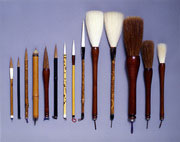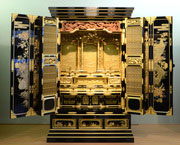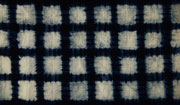Niigata and more
- Sort by
- Popularity
- Name
-
Hagi ware Hagi yaki
- Ceramic
- Yamaguchi

Hagi ware (called Hagi yaki in Japanese) is a form of porcelain produced mainly in the city of Hagi in Yamaguchi prefecture. Hagi ware is rarely decorated, remaining as simple as possible to make the most of the features of the clay. This simplici…
View more
-
Tobe ware Tobe yaki
- Ceramic
- Ehime

Tobe ware (called Tobe yaki in Japanese) is a form of ceramic ware produced around the town of Tobe in Iyo district of Ehime prefecture. Production began in the middle of the Edo period (1603-1868) and it was registered as a traditional craft by t…
View more
-
Tokoname ware Tokoname yaki
- Ceramic
- Aichi

Tokoname ware (Tokoname yaki in Japanese) is a form of ceramic pottery that is produced in the area around the city of Tokoname in Aichi prefecture. This traditional craft comes from one of the Six Ancient Kilns of Japan. Along with Bizen, Tamba, …
View more
-
Ojiya chijimi textiles Ojiya chijimi
- Woven textiles
- Niigata

Ojiya chijimi textiles (called Ojiya chijimi in Japanese) is a handicraft produced from ramie in the area around the city of Ojiya in Niigata prefecture. Ramie is a tall plant of the nettle family that has been used to make cloth for centuries. R…
View more
-
Kiso lacquerware Kiso shikki
- Lacquerware
- Nagano

Kiso lacquerware (called Kiso shikki in Japanese) is produced in Kiso district, now the city of Shiojiri, Nagano prefecture. The area where this craft is produced is a plateau approximately 900 meters above sea level. The climate has cool summers…
View more
-
Matsumoto furniture Matsumoto kagu
- Wood, bamboo crafts
- Nagano

Matsumoto kagu is a type of Japanese traditional furniture made in the city of Matsumoto in Nagano prefecture and has been produced for over three hundred years, since the Edo period (1603-1868). The Second World War led production of this craft t…
View more
-
Shiozawa tsumugi silk Shiozawa tsumugi
- Woven textiles
- Niigata

Shiozawa tsumugi is a silk textile produced in the former town of Shiozawa (now a part of the city of Minamiuonuma), Niigata prefecture. The area is known for its heavy snowfall and wet winter climate which are ideal for weaving. Echigo jofu, a fa…
View more
-
Akama inkstone Akama suzuri
- Writing tools
- Yamaguchi

Akama inkstone (called Akama suzuri in Japanese) is produced around the cities of Shimonoseki and Ube in Yamaguchi prefecture. A type of stone called akama, an ideal material for producing the inkstones, is used for Akama inkstone. Therefore this …
View more
-
Suruga bamboo crafts Suruga takesensuji zaiku
- Wood, bamboo crafts
- Shizuoka

Suruga bamboo ware (called Suruga take sensuji zaiku in Japanese) is produced in the city of Shizuoka, Shizuoka prefecture. High quality bamboo has grown wild in the basin of the upper reaches of the Abe River in Shizuoka since ancient times. Bamb…
View more
-
Akazu ware Akazu Yaki
- Ceramic
- Aichi

Akazu ware (called Akazu yaki in Japanese) is a form of pottery produced around Akazucho in the eastern part of the city of Seto, Aichi prefecture. This craft is a type of Seto ware, one of Japan's Six Ancient Kilns. Together with Bizen, Tamb…
View more
-
Ouchi lacquerware Ouchi nuri
- Lacquerware
- Yamaguchi

Ouchi lacquerware (called Ouchi nuri in Japanese) is produced around the city of Yamaguchi, in Yamaguchi prefecture. This craft emerged under the Ouchi clan, which boasted significant influence and power in the region during the Muromachi period (…
View more
-
Toyohashi brushes Toyohashi fude
- Writing tools
- Aichi

Toyohashi brushes are calligraphy brushes produced in the area around the city of Toyohashi, Aichi prefecture. They are known as high quality brushes and the favorite of many calligraphers. There are over a hundred types of brushes that are not on…
View more
-
Hon-shiozawa silk Hon shiozawa
- Woven textiles
- Niigata

Hon-shiozawa is a textile produced in the former town of Shiozawa (now a part of the city of Minamiuonuma), Niigata prefecture. It is one of the textiles that represent the region, which is famous for linen and silk textile production. This craft …
View more
-
Nagoya textiles Nagoya yuzen
- Dyed textiles
- Aichi

Nagoya yuzen is a cloth that is dyed and painted through a range of traditional techniques that are unique to the city of Nagoya, Aichi prefecture. The designs used for this craft range from monochromatic, color gradation, or classical motifs, but…
View more
-
Ojiya tsumugi silk Ojiya tsumugi
- Woven textiles
- Niigata

Ojiya tsumugi is a silk fabric produced in the area around Ojiya, Niigata prefecture, which is a city known for heavy snow. Echigo jofu, a textile made of ramie, has been produced in this area for over a thousand years. As new weaving techniques …
View more
-
Niigata lacquerware Niigata shikki
- Lacquerware
- Niigata

Niigata Lacquerware (called Niigata Shikki in Japanese) is a form of lacquerware produced in the area around the city of Niigata, Niigata prefecture. This craft has various coating techniques such as hana-nuri, ishime-nuri, nishiki-nuri, isokusa-n…
View more
-
Ozu traditional Japanese paper Ozu washi
- Traditional Japanese paper
- Ehime

Ozu traditional Japanese paper (called Ozu washi in Japanese) is a handmade paper made in the town of Uchiko, Ehime prefecture. The history of papermaking of Ozu washi dates back to the Heian period (794-1185), and the current style of Ozu washi e…
View more
-
Shinshu tsumugi silk Shinshu tsumugi
- Woven textiles
- Nagano

Shinshu tsumugi is a type of silk fabric also known as pongee and produced throughout Nagano prefecture. Each region in the prefecture has their own production styles and techniques. Also, the specific name of this fabric differs depending on the …
View more
-
Iiyama Buddhist altar Iiyama butsudan
- Household Buddhist altars
- Nagano

Iiyama Buddhist Altars, called Iiyama Butsudan in Japanese, are made around the city of Iiyama, Nagano prefecture. Iiyama is known for its people being devout to Buddhism since ancient times, which sustains the tradition of altar production. This …
View more
-
Kamo traditional chest Kamo kiri tansu
- Wood, bamboo crafts
- Niigata

Kamo Kiri Tansu are chests of drawers made of paulownia wood that are produced in and around the city of Kamo, Niigata prefecture. Today, a majority of all paulownia chests made in Japan are produced in Kamo. This craft can keep clothes safe from …
View more
-
Nagoya Buddhist altar Nagoya butsudan
- Household Buddhist altars
- Aichi

Nagoya Buddhist Altars (called Nagoya Butsudan in Japanese) are produced around the city of Nagoya, Aichi prefecture. Usually high grade trees such as Japanese cypress, zelkova, or sandalwood are used for the base. Nagoya Buddhist Altars have a hi…
View more
-
Owari Cloisonné Owari shippo
- Other crafts
- Aichi

Owari Cloisonné (called Owari Shippo in Japanese) is a type of enamelware, produced in Ama and Nagoya, Aichi prefecture, that is decorated with vibrant colorful designs often depicting natural scenery or the beauty of nature. The name shippo refer…
View more
-
Murakami carved lacquerware Murakami kibori tsuishu
- Lacquerware
- Niigata

Murakami Carved Lacquerware (called Murakami Kibori Tsuishu in Japanese) is produced in the area around Murakami, Niigata prefecture. The region, which was formerly the Murakami domain, has been famous for its production of natural lacquer since t…
View more
-
Tsubame-tsuiki copperware Tsubame tsuiki doki
- Metal works
- Niigata

Tsubame-tsuiki Copperware (called Tsubame Tsuiki Douki in Japanese) is a type of metalware made on the outskirts of Tsubame, Niigata prefecture. Since the middle of the Edo period (1603-1868), kettles and other crafts have been produced from coppe…
View more
-
Uchiyama Japanese paper Uchiyama gami
- Traditional Japanese paper
- Nagano

Uchiyama Gami is a type of traditional Japanese paper made in the Oku-shinano region of northern Nagano prefecture. As a region that gets heavy snowfall during the winter, papermaking production developed to provide supplementary income. This craf…
View more
-
Arimatsu tie-dyeing Arimatsu narumi shibori
- Dyed textiles
- Aichi

Arimatsu Narumi Shibori is a tie-dye fabric produced in the area surrounding Nagoya, Aichi prefecture. Many of the tie-dye products in Japan are produced here. The tie-dye products are designated as a traditional national craft. Arimatsu Narumi Sh…
View more
-
Mikawa Buddhist altar Mikawa butsudan
- Household Buddhist altars
- Aichi

Mikawa Buddhist Altars, called Mikawa Butsudan in Japanese, are made in the Mikawa area of Okazaki, Aichi prefecture. In the region, as it was a custom to place a Buddhist altar in the closet, there were demands to make the pedestal of the altar l…
View more
-
Seto-sometsuke ware Seto sometsuke yaki
- Ceramic
- Aichi

Seto Sometsuke ware (called Seto Sometsuke yaki in Japanese) is ceramic ware produced near the cities of Seto and Owariasahi in Aichi prefecture. The term sometsuke is normally used when designs are painted on porcelain with an indigo blue pigment…
View more
-
Shinshu Forged Blades Shinshu uchihamono
- Metal works
- Nagano

Shinshu Forged Blades or Shinshu Uchihamono in Japanese, are metalworks produced around Nagano, Nagano prefecture. As this area was formerly a province called Shinano which was also called Shinshu, these blades are known under the name of "Sh…
View more
-
Echigo-sanjo cutlery Echigo sanjo uchihamono
- Metal works
- Niigata

Echigo-Sanjo Uchihamono are hammer-forged blades produced in Sanjo City, Niigata prefecture. Unlike modern blades made using the stamp pressing and polishing techniques developed after the second world war, these blades are produced by hand-hammer…
View more































































































































































































































































































